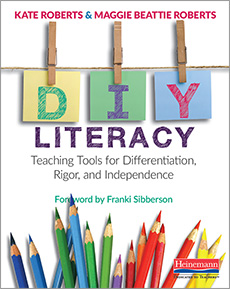"The tools in our lives improves our lives. They save us energy, time, and struggle." pg. 3
This book hits such an important topic that I have always struggled with: how to create effective and visually stimulating tools that truly invigorate the students to work independently. As a 4th grade teacher, I am always striving to get the children that come into my room at the start of the year to grow into independent thinkers and problem solvers.
Chapter One: Extending Our Reach
I love how chapter one starts out. It reminds us that the right tool is essential to success in most situations. Something that I love to do is cook. When I first started to experiment with made from scratch foods, I had limited kitchen tools and it became very difficult to create the delicious foods I wanted. It quickly became obvious to me that it was essential that I purchase certain kitchen tools, such as a rolling pin, different sized graters, a mandolin, and most importantly a food processor. With these, cooking became so much easier and I was able to complete more complex and delicious foods. As a cook, I knew these tools were helpful and allowed me to combine the skills of using these in many different ways to create new dishes. The same is true in the classroom. With the right tools, students can succeed and become independent. And the more tools we provide, the more likely that the students' learning will be complex and lasting.
Chapter Two: An Introduction to Teaching Tools
I currently have my students each keep a notebook in the classroom that is full of the notes, examples, lists, and other helpful tools. It stays in the classroom where they can access it whenever they need to while working. However, as I get into this book, I am realizing that it is lacking some key ingredients. First, it is definitely not interactive enough. Although many of the examples of good, "after" work are created together, I have never had students create their own bookmark list of strategies that work for them, rather, every strategy that is an option is always included in the tools. Second, I need to use more images, icons, and other visual clue elements. Third, I need to include far more examples of the "before" work so that students can see where they are now in order to figure out how to get to better and reach quality "after" work.
My favorite tool that is shown in Ch. 2 is the demonstration notebook. I always struggle with making my mini-lessons truly mini, and with being able to timely pull out small groups for effective reteaching or refining lessons. The demonstration notebook is a great solution to both of these struggles. It allows me to be ready with hands-on practice of valuable skills and strategies for when the need presents itself in the classroom. I am getting excited about starting to create my notebook and other charts! I know it will take time to create a quality notebook and truly beneficial charts and micro-progressions, but it will be worth it!
Bonus Chapter: How Do I Find (and Write) Strategies for Teaching Tools?
This chapter was more of a confirmation that I have been on the right track for the past 4-5 years. My district has been going through major curriculum changes the past few years as the Common Core standards are introduced and as the state tests have changed over and over. In order to compensate, I have done a lot of finding and writing my own strategies for my students' ELA binders. I especially appreciate the Fine-Tuning Your Strategies section. These were great reminders to help make the strategies I give to students truly kid-friendly. It really is all about the kids!
I want to end with this great reminder found on page 6: "You will also need good teaching practices, a strong curriculum, and solid relationships with your kids."


I'm with you... finding more visual clue elements is something I need to do too! Pairing an image with text just helps so much! And I LOVE your cooking connection!
ReplyDeleteI enjoyed reading about how you connected the cooking from scratch and the creating of authentic tools from K & M book! I agree that using the right tools makes all the difference. I truly believe that the tools Kate and Maggie have shared will make all the difference because it will be students who are doing the work.
ReplyDeleteI love the quote you lifted from the text.
ReplyDelete